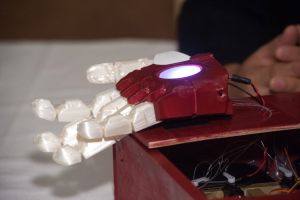

A cross-discipline capstone project at the New York City College of Technology (City Tech) led students Jiaman Zhao, Mohamed Alborati, and Teddie Lai to change their career plans.
At the 2017 ATE Principal Investigators Conference the three associate degree graduates exhibited the prosthetic hand with embedded sensors that they fabricated with a 3-D printer and programmed using multiple hardware and software systems. In interviews they explained the project's unexpected impact on their lives: Zhao wants to work in a hospital prosthetics department while he completes his bachelor's degree; Alborati changed his major from mechanical engineering to computer engineering; and Lai plans to be a prosthetics designer rather than enter the military as a computer technician.
"Of course we are going to make it better," and "We have a lot of options," are just two of Lai's statements that sum up the students' takeaways from the ATE-funded mechatronics project (#1601522) that has computer science and electro-mechanical technology students create medical devices together.
The students' confidence and their determination to develop better functioning, more realistic-looking prosthetics seems to be a direct result of all the problems that they had to solve while designing the hand.
Yu Wang, an assistant professor in Computer Engineering Technology at City Tech (which is part of the City University of New York), said the students brainstorming involved multiple experiments with various hardware and software before they decided to use Python and C++ software, and Arduino and Raspberry Pi hardware.
Though the trial-and-error process takes time, Wang said having real data to monitor and a meaningful, tangible outcome engages students.
The students also received lots of positive feedback and advice when Andy S. Zhang, professor of Mechanical Engineering & Industrial Design Technology Department, took them to the New York City Maker Faire.
Rising to the Challenge
"Nowadays everything is mechatronics because of robots," Zhang said.
But it is the human aspect of the project, specifically the intricate mechanics and complex programming involved in the simplest of hand movements and the challenges that amputees contend with, that captivated the attention of these three students.
Zhao said he had never even thought about prosthetics prior to another City Tech course that required a small project involving a prosthetic hand as mid-term project. Afterward he asked the professor about other prosthetic projects. He proudly points out that the prosthetic hand that he, Alborati and Lai were operating at the conference has 170 pieces, an opposable thumb, and flexible fingers.
"My ultimate goal is maybe have it play the piano or something like that," he said.
Alborati discovered during the project that he has a knack for computer programming. His CUNY associate degree is in electro-mechanical technology. He applied the electrical concepts he learned in that program to his work on the sensors inside the hand.
Lai, who calls Alborati a "genius software person," has been interested in computer programming since middle school when her interest in gaming led to building her own computer and server.
She describes the team's ongoing work to improve the prosthetic hand's movement as "like a brand new robot. You have to teach it."
Individually and as a team, their goal is to improve the function of prosthetics and lower their costs. They are aware that more capable prosthetics are on the market, but they are too costly for many people. The team also thinks they've figured out ways to use smart phone technologies, cloud services, WIFI other technologies to utilize data in ways that help amputees, their families, and physicians.
"If you really want to and you are creative, you can build anything with any of the components we are using today," Lai said.
Later in the interview, she added, "As long as you have your mind set—Hey I want to build this, let's try it—I think your creativity can continue onward."

 Subscribe
Subscribe


 See More ATE Impacts
See More ATE Impacts

Comments
There are no comments yet for this entry. Please Log In to post one.